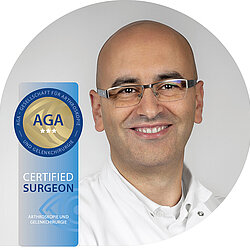Whether sports injury, accidental injury, fracture of the upper or lower extremity, consequence of injury or wear-related disease - our team of experts at the Center for Special Joint and Trauma Surgery will be happy to advise you on injuries or diseases of the shoulder, elbow, knee or ankle joint. After careful analysis of your complaints, we will draw up a treatment concept tailored to your individual needs. The most modern surgical and treatment methods are used, taking into account the latest scientific findings. Thanks to the extensive experience of our specialists, you benefit from the highest level of routine and expertise.
If surgery becomes necessary, we use minimally invasive or arthroscopic procedures. Most joint injuries or diseases can be treated extremely precisely by arthroscopy. As a patient, you benefit not only from the smaller skin incision, but also from less pain, faster rehabilitation and a better functional result due to less scarring as a result of the tissue-sparing procedure.
Our primary goal is the preservation of the joint or the restoration of joint function. We can also offer joint-preserving procedures for incipient osteoarthritis.
If joint preservation is no longer possible, bone-saving endoprostheses that can be individually adapted to you are available.
Knee
- meniscus suture, meniscus transplantation
- all cartilage therapy procedures including cartilage cell transplantation
- anterior cruciate ligament reconstruction (hamstring, quadriceps or patellar tendon graft)
- posterior cruciate ligament reconstruction
- cruciate ligament revision surgery
- complex ligament stabilization (multi-ligament injuries)
- Leg axis correction
- stabilization of the kneecap (MPFL-plasty, trochleaplasty, tuberosity offset)
- surgical stabilization of tibial plateau fractures, patella fractures and joint fractures of the femur
Shoulder
- Extension of the acromion and removal of the calcific deposit
- Capsule release for frozen shoulder
- Rotator cuff suture
- Capsular reconstruction for mass defects of the rotator cuff
- Shoulder stabilization including bony glenoid reconstruction
- Treatment of long biceps tendon disorders
- Stabilization of the acromioclavicular joint
- surgical therapy of early shoulder arthrosis (CAM procedure)
- insertion of an artificial shoulder joint (anatomical and inverse total shoulder endoprosthesis)
- Shoulder total endoprosthesis replacement surgery
- treatment of glenoid fractures of the shoulder
- surgical stabilization of fractures of the upper arm and clavicle
Elbow
- Surgical therapy of tennis and golfer's elbow
- Stabilization of the unstable elbow including ligament reconstruction (LUCL, MUCL)
- Cartilage therapy of the elbow
- capsule release for elbow stiffness
- Surgical therapy of early elbow osteoarthritis
- Insertion of an artificial elbow joint and radial head prosthesis
- nerve decompression at the elbow (Sulcus ulnaris syndrome)
- surgical stabilization of joint fractures of the upper and lower arm

Dagmar Alms
Secretariat Shoulder, elbow, knee surgery and traumatology
- Phone+49 2351 945-2305
- Fax+49 2351 945-2307
- sekretariat.leyh@hellersen.de









